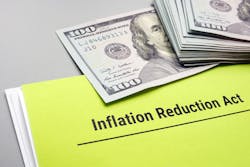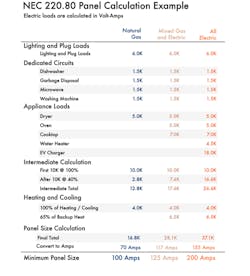Inflation Legislation Funds Panel, Wiring Upgrades
Demand for residential electrical infrastructure improvements could be poised for growth with recent Congressional passage of the Inflation Reduction Act of 2022 (IRA).
While new incentives for electrical service and wiring upgrades are a miniscule part of the sweeping legislation, they could prove pivotal in laying the groundwork for improvements to energy efficiency across the economy, which is one of the package's central aims. Tax credits and rebates for such improvements were included because boosting residential energy efficiency in an environmentally friendly way will demand expanded electrification. Homes getting increasingly more energy from electricity than fossil fuels and seeing that load increase as well will, in turn, need robust electrical service capabilities, something many lack.
Inclusion of incentives for electrical upgrades may have been spurred by growing research into the route to expanded electrification. One such effort, by Pecan Street, Inc., Austin, Texas, yielded a 2021 paper, Addressing an Electrification Roadblock: Residential Electric Panel Capacity in 2021. Claiming that millions of homes are unprepared for fuller electrification because of an insufficient infrastructure, the paper proposes remedies.
“Regardless of the age of a home, our analysis shows that an electric panel below 200A will likely require an electric panel upgrade or other load management system before it can fully electrify with current building codes and technology,” it states (see Figure). “Our results point to as many as 48 million households that may require such an upgrade in order to electrify. If an electric panel upgrade is assumed to cost $2,000 on average, this is as much as a $100 billion impediment to residential electrification in America. Policymakers should see this as an opportunity to enact electrification policies and incentive programs that ensure homeowners, especially low-to-moderate-income homeowners, are not left with the bill during the transition to full electrification.”
The IRA seeks to ensure that by including electrical panel and wiring improvements in a broad mix of “green” and energy efficient projects eligible for government funding assistance. In addition to providing rebates for upgrades to more energy efficient appliances the IRA’s new High-Efficiency Electric Home Rebate Program offers rebates of up to $2,500 for electric wiring and up to $4,000 for electric load service center upgrades for qualifying households. And under the law’s new Energy Efficient Home Improvement Credit, electrical panels and related equipment are eligible for up to $600 in federal tax credits if they conform to guidelines.
If more existing homes can be improved – and new homes can be built – to handle the higher electrical loads that will be needed to move away from fossil fuels and utilize cleaner energy, rebates, and credits will prove to be good investments, Pecan Street says. Combined with building and energy code revisions that address residential electrical infrastructure, they will simplify the route to expanded electrification, improved energy efficiency, and a cleaner environment.
“Electric panel capacity has been a little-known electrification issue but one that presents a substantial roadblock to full electrification,” the research report concludes. “If we are to achieve the ambitious greenhouse gas emissions reductions required to avoid the worst-case climate scenarios described by the August 2021 Intergovernmental Panel on Climate Change (IPCC), policymakers, and utilities should support the rapid electrification of the 35 to 45 million homes that can electrify with their existing electric panels. Further, they need to act to remove the significant infrastructure, cost and logistical challenges to homes that need a panel upgrade to electrify.”
Tom Zind is a freelance writer based in Lees Summit, Mo. He can be reached at [email protected].
About the Author
Tom Zind
Freelance Writer
Zind is a freelance writer based in Lee’s Summit, Mo. He can be reached at [email protected].

